#verbena bonariensis the butterflies LOVE
Explore tagged Tumblr posts
Text
Seeds Purchased from Stonecrop Gardens, NY
One of the biggest benefits of membership at Stonecrop is access to their amazing seed bank. Members can purchase rare seeds for $1 a pack. These are plants that are sometimes extremely difficult to find at nurseries and that work perfectly for my area. Here is a list of what I purchased from them...some I've already begun.
The seed collection got suddenly a lot more interesting.
Rarium: Centaurea macrocephala
Rarium: Digitalis parviflora
Rarium: Echinops exaltatus
Rarium: Hosta sieboldiana var. elegans
Rarium: Polygonatum giganteum
Rarium: Salvia coccinea 'Brenthu
Seminum: Acmella oleraceae
Seminum: Actaea japonica (syn. Cimicifuga japonica)
Seminum: Actaea racemosa (syn. Cimicifuga racemosa)
Seminum: Actaea simplex 'Brunette' (syn. Cimicifuga ramosa 'Brunette'
Seminum: Agastache foeniculum 'Alba'
Seminum: Allium angulosum
Seminum: Allium tuberosum
Seminum: Amaranthus hybridus var. erythrostachys
Seminum: Ammi visnaga
Seminum: Anemone virginiana
Seminum: Anethum graveolens
Seminum: Angelica gigas
Seminum: Anthriscus sylvestris 'Raven's Wing'
Seminum: Aster tataricus
Seminum: Astilboides tabularis (syn. Rodgersia tabularis)
Seminum: Astrantia major
Seminum: Calendula officinalis
Seminum: Campanula takesimana 'Alba'
Seminum: Cuphea viscosissima
Seminum: Cynoglossum amabile ‘Firmament’
Seminum: Emilia coccinea
Seminum: Helleborus orientalis
Seminum: Ipomoea lobata (syn. Mina lobata)
Seminum: Monarda punctata
Seminum: Nigella damascena 'Miss Jekyll Blue'
Seminum: Papaver somniferum Mix
Seminum: Salvia farinacea
Seminum: Verbena bonariensis

Anemone virginiana. Interesting thing about this plant is that for years I've pulled it thinking it was a weed. On the years that I forgot to pull it, I was like, man that is pretty! So I now leave it alone. It's drought tolerant and the flowers are loved by pollinators. I'll be planting some more from seed as well.

Anethum graveolens - Dill
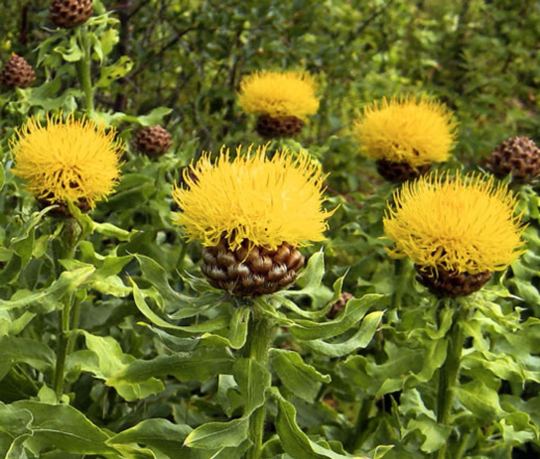
Centaurea macrocephala - Started Seeds 5/3/2024 - This plant is too cool for school!
Category: Rarium | Sub-Category: Perennials for Sun
Scientific Name (Genus/Species): Centaurea macrocephala
Family: (Asteraceae)
(P) to 3′. Great Golden Knapweed. Caucasus. A large, leafy, robust plant bearing sturdy stems topped with incredible, rich golden yellow, hemispherical, thistle-like blooms. The fringed, rusty brown coloured involucre of bracts is very prominent and persists. Midsummer. Makes excellent dried cut flowers. Sun. 3, D & T2

Digitalis parviflora - Started seeds 5/3/2024 - Really different foxglove. Love it.
Category: Rarium | Sub-Category: Perennials for Sun
Scientific Name (Genus/Species): Digitalis parviflora
Family: (Plantaginaceae)
(P) to 2′. Spanish Foxglove. This is a true perennial species of Foxglove, native to the mountains of northern Spain. Plants form a rosette of dark, deeply veined, green leaves bearing in early summer, tightly packed spikes of small, rusty orange-red to chocolate brown flowers on stiff, leafy, upright stems. Eye-catching. Well-drained soil. Sun. 4 & T2

Echinops exaltatus
Category: Rarium | Sub-Category: Perennials for Sun
Scientific Name (Genus/Species): Echinops exaltatus
Family: (Asteraceae)
(P) to 6′. Tall Globe Thistle. Eastern Europe to Russia. Globular flowerheads composed of numerous, tiny, pale blue florets. Flowerheads to 2-½ inches in diameter stand tall on sturdy, downy-white stems and mature into dense, prickly seedheads. The bold, greyish green, thistle-like foliage forms an impressive clump. This summer-to-fall bloomer is a magnet for bees, hoverflies and butterflies. Sun. 4 & T2
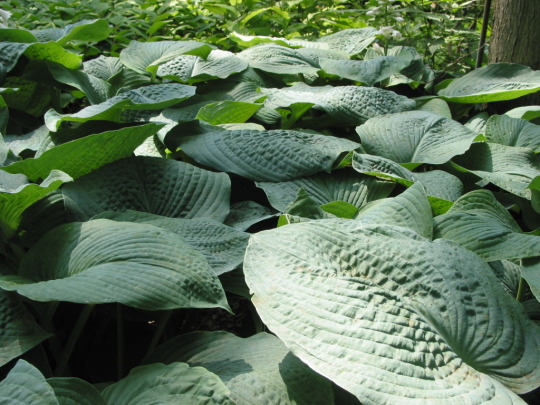
Hosta sieboldiana var. elegans
Category: Rarium | Sub-Category: Woodland
Scientific Name (Genus/Species): Hosta sieboldiana var. elegans
Family: (Asparagaceae)
(P) to 3′. “…most sumptuous of all the Hostas.” (GST**). Huge, broad, glaucous, heavily textured, bluish green leaves form magnificent, stately clumps that add accent and poise to the woodland garden. The pale lilac-white flowers appear in early to midsummer, though they barely emerge from beneath the foliage. 3 & T3, then it may need 40º for 2-3 months.
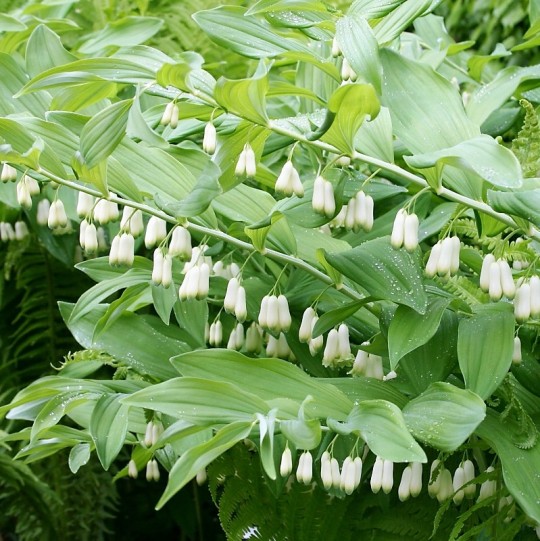
Polygonatum giganteum - Started 5/3/24
Category: Rarium | Sub-Category: Woodland
Scientific Name (Genus/Species): Polygonatum giganteum
Family: (Asparagaceae)
(P) to 7′. Giant Solomon’s Seal. Statuesque and unmistakable. This spectacular giant is similar to Polygonatum biflorum in everything but size. Bell-shaped, greenish white, tubular flowers hang from the tall arching stems in early summer with the dark blue berries following in fall. Moist soil. Shade/partial shade. 3 & 6
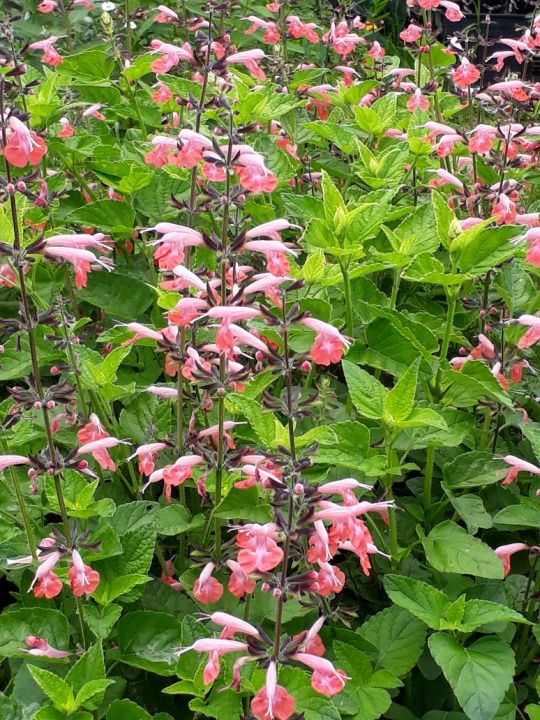
Salvia coccinea 'Brenthurst'
Category: Rarium | Sub-Category: Annuals for Sun
Scientific Name (Genus/Species): Salvia coccinea 'Brenthurst'
Family: Lamiaceae
(A/TP) to 2.5′. A cool-coloured cousin of the red bedding Salvia with numerous spikes of bicoloured, lipped blooms. The pale whitish pink upper hoods and three lobed, deeper pink lower lips contrast nicely against the dark tinted calyces and stems. Blooms late summer and lasts until frost. Sun. 4 & T2

Acmella oleraceae - Toothache Plant
Category: Seminum | Sub-Category: Annuals for Sun
Scientific Name (Genus/Species): Acmella oleraceae
Family: (Asteraceae)
(A) to 10″. Toothache Plant. South America. A profusion of rounded, orange-yellow disc florets with brownish red centres resemble eyeballs. Creeping, bronze-green foliage has numbing properties when chewed, hence the common name. Easy to grow. Very unusual and fun; a “must have”. Summer blooming. Sun. 3 & 6
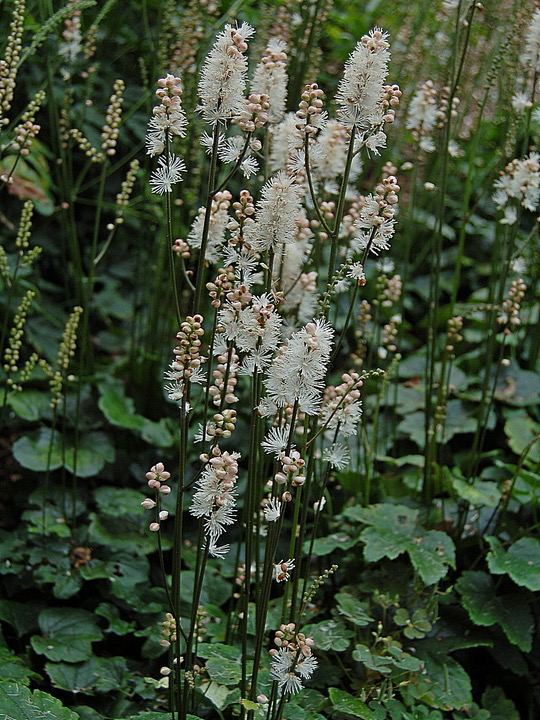
Actaea japonica (syn. Cimicifuga japonica) - snakeroot
Category: Rarium | Sub-Category: Woodland
Scientific Name (Genus/Species): Actaea japonica var. acerina (syn. Cimicifuga japonica var. acerina)
Family: (Ranunculaceae)
(P) to 3′. A Japanese native with handsome maple-like foliage that has long, pointed lobes. Slender branched spikes of white, tufted flowers bloom in September and October. Moist soil. Sun/partial shade. 3 & 6A

Actaea racemosa (syn. Cimicifuga racemosa)
Category: Seminum | Sub-Category: Woodland
Scientific Name (Genus/Species): Actaea racemosa (syn. Cimicifuga racemosa)
Family: (Ranunculaceae)
(P) to 6′. Early Snakeroot, Black Cohosh. An eastern North American native with branched wands of white, bottlebrush flowers. Blooms prolifically in June. Light green, divided foliage remains at three feet tall. Partial shade. 3 & 6A
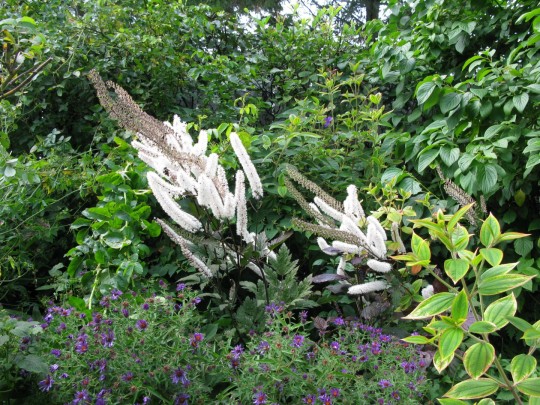
Actaea simplex 'Brunette' (syn. Cimicifuga ramosa 'Brunette')
Category: Seminum | Sub-Category: Woodland
Scientific Name (Genus/Species): Actaea simplex 'Brunette' (syn. Cimicifuga ramosa 'Brunette')
Family: (Ranunculaceae)
(P) to 6′. One of the darkest leaved Cimicifugas. Stems are a rich purplish brown with pure white, upright, fragrant flower spikes in September. Not all seedlings will be as dark as ‘Brunette’, but definitely worth a try. Partial shade. 3 & 6A

Agastache foeniculum 'Alba'
Category: Seminum | Sub-Category: Perennials for Sun
Scientific Name (Genus/Species): Agastache foeniculum 'Alba'
Family: Lamiaceae
Short-lived perennial to 3.5′. White Anise Hyssop. A white cultivar of the above. Sun/partial shade. 4 & T2
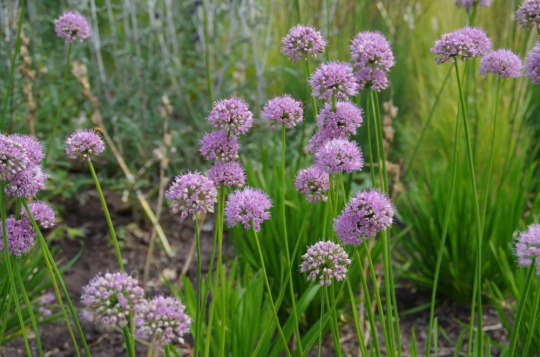
Allium angulosum - mouse garlic
Category: Seminum | Sub-Category: Bulbs
Scientific Name (Genus/Species): Allium angulosum
Family: (Alliaceae)
Hardy bulb to 16″. Mouse Garlic. Europe. Loose heads formed by multiple, cup-shaped flowers of pale purple. Blooms June to August. Sun. 3 & 6
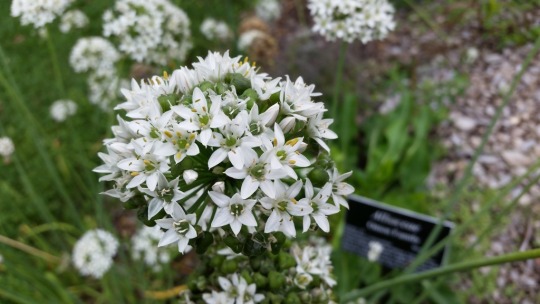
Allium tuberosum - this already grows wild here
Category: Seminum | Sub-Category: Bulbs
Scientific Name (Genus/Species): Allium tuberosum
Family: (Alliaceae)
Hardy bulb to 18″. Garlic Chives. Southeast Asia. Spherical, white blooms freshen the flower garden throughout August. Sun/partial shade. 3 & 6
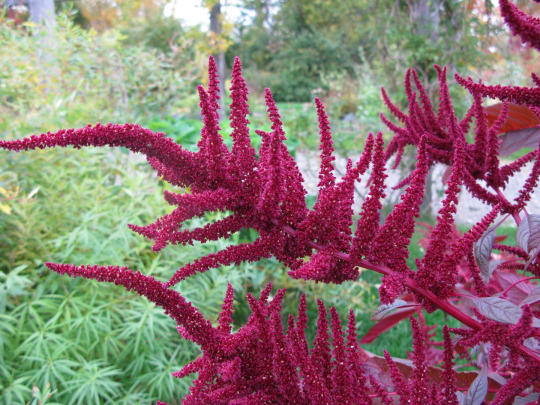
Amaranthus hybridus var. erythrostachys
Category: Seminum | Sub-Category: Annuals for Sun
Scientific Name (Genus/Species): Amaranthus hybridus var. erythrostachys
Family: (Amaranthaceae)
(A) to 5′. Peruvian Tassel Flower. Many branched panicles of crimson, tassel-like flowers accentuated by the deep maroon foliage of this plant, creates drama in the border. Sun. 3 & T3
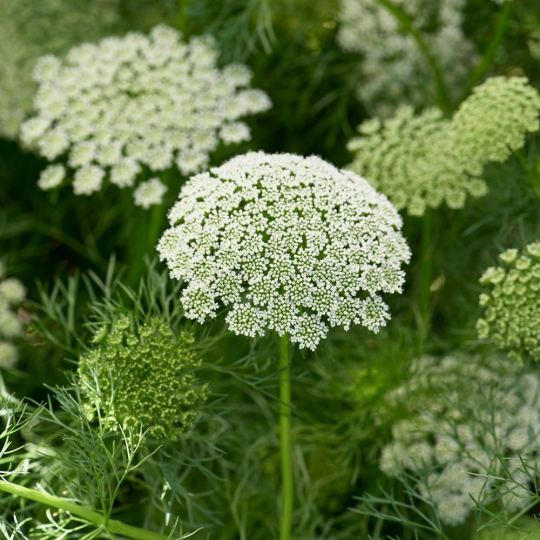
Ammi visnaga - Started Seeds 5/3/2024
Category: Seminum | Sub-Category: Annuals for Sun
Scientific Name (Genus/Species): Ammi visnaga
Family: (Apiaceae)
(A) to 3′. Khella, Toothpick Plant. Egypt. Grown since antiquity for medicinal purposes. This sophisticated Queen Anne’s Lace relative produces masses of feathery, delicate, aromatic foliage topped with wide, compound, flat umbels of tiny, greenish-white flowers. An excellent and unusual filler; most desirable for cut flower displays. Well-drained soil. Sun. 3 & T1
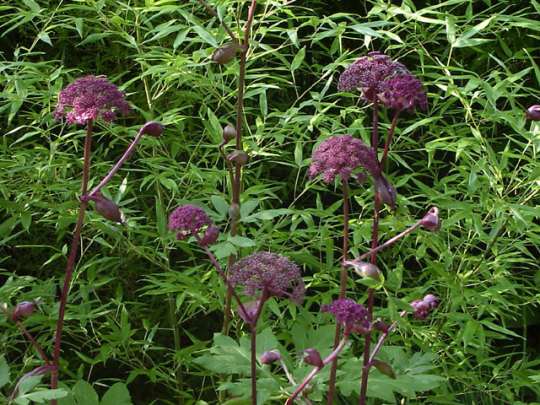
Angelica gigas - Started seeds 5/3/2024
Category: Seminum | Sub-Category: Perennials for Sun
Scientific Name (Genus/Species): Angelica gigas
Family: (Apiaceae)
(B/P) to 5′. This terrific Barry Yinger introduction from Korea and Japan is a stunner. Dramatic, deep maroon, spherical flowerheads emerge from red-flushed, bulbous, leafy sheaths above glossy green, dissected foliage. The afternoon sun intensifies the colour and lends this plant another dimension. Please note, insects, especially hornets, also find it irresistible. Sun/partial shade. 3 & 6
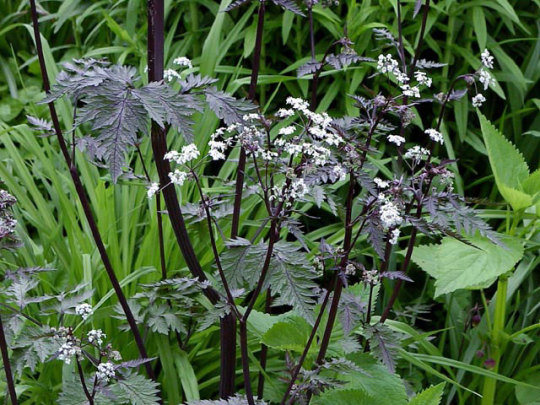
Anthriscus sylvestris 'Raven's Wing'
Category: Seminum | Sub-Category: Perennials for Sun
Scientific Name (Genus/Species): Anthriscus sylvestris 'Raven's Wing'
Family: (Apiaceae)
(B/P) to 5′. Lacey compound umbels of tiny, five-petalled, creamy white flowers, reminiscent of Queen Anne’s Lace, float on hollow, dark stems above fern-like, dusky purple-coloured foliage. Long bloomer that provides an airy elegance to the border. Always admired in our Flower Garden. Self-seeds gently. Sun/partial shade. 3 & 6
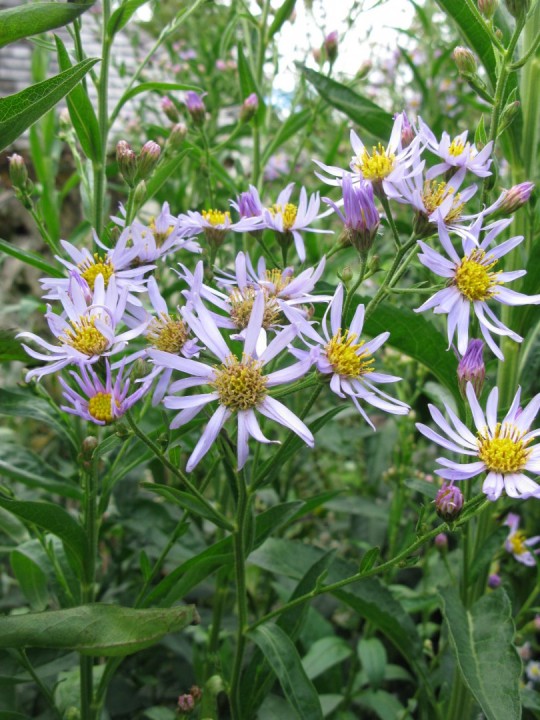
Aster tataricus - this is already thriving in the garden
Category: Seminum | Sub-Category: Perennials for Sun
Scientific Name (Genus/Species): Aster tataricus
Family: (Asteraceae)
(P) to 7′. Tatarian Aster. Siberia. Tall, long-blooming Aster with glorious, loose sprays of bold, lilac-blue daisies with yellow centres. Dense clusters of wide, lance-shaped leaves. Tough, durable plant that will thrive in a variety of conditions. No staking needed, blooms late – September and October and well worth the wait. Sun/partial shade. 3 & 6 & Δ
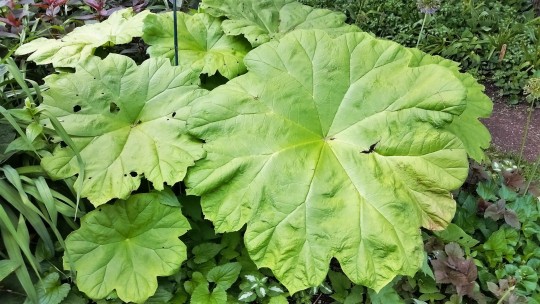
Astilboides tabularis (syn. Rodgersia tabularis) - Planted some last year, started a bunch of seeds - we'll see. 5/3/2024
Category: Seminum | Sub-Category: Woodland
Scientific Name (Genus/Species): Astilboides tabularis (syn. Rodgersia tabularis)
Family: (Saxifragaceae)
(P) to 4′. William Robinson described it best, “A bold growing and handsome species with huge peltate leaves and plumes of creamy white flowers.” Leaves reach a height of 2 to 2.5 feet. A superb plant to use as a focal point in the garden. Definitely stimulates conversation. Partial shade. 4 & T2

Astrantia major
Category: Seminum | Sub-Category: Woodland
Scientific Name (Genus/Species): Astrantia major
Family: (Apiaceae)
(P) to 2.5′. Great Masterwort. Central and eastern Europe. No garden should be without this effortless and beautiful plant. Several greenish white, often blushed pink flowerheads each arranged in a dome with a “collar” of bracts. Dense clumps of divided basal foliage. Content in the flower garden or in the woodland. Summer blooming. Great in flower arrangements, too. Sun/partial shade. PC- 4 weeks. 4 & 7 for 4 weeks, then T2

Campanula takesimana
Category: Seminum | Sub-Category: Woodland
Scientific Name (Genus/Species): Campanula takesimana 'Alba'
Family: (Campanulaceae)
(P) to 2′. Korea. An outstanding white variety of the beautiful Campanula takesimana. Leaves large in basal rosettes. Branched inflorescence of large, pendant bells on nodding stalks. Flowers are pure white with purple spotting within. Blooms July to September. Sun/partial shade. 4 & T2
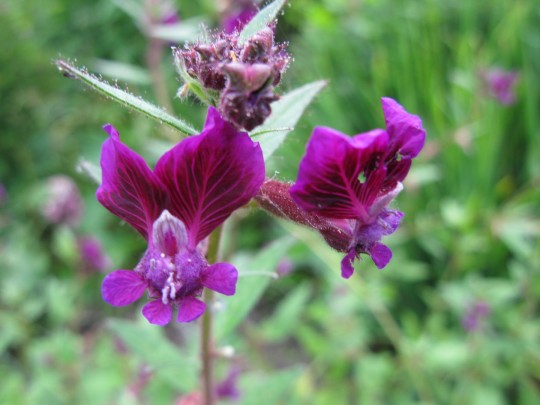
Cuphea viscosissima - Seeds already started 5/3/2024
Category: Seminum | Sub-Category: Annuals for Sun
Scientific Name (Genus/Species): Cuphea viscosissima
Family: (Lythraceae)
(A) to 20″. Blue Waxweed. A North American native and one of our most revered annuals. This non-stop summer bloomer has six deep, magenta-purple petals with the upper two being the longest and a tubular green calyx covered in fine purple hairs. An easy-care annual that requires no deadheading or staking. Very sticky stems trap unsuspecting insects. Self-sows. Sun. 4 & T3
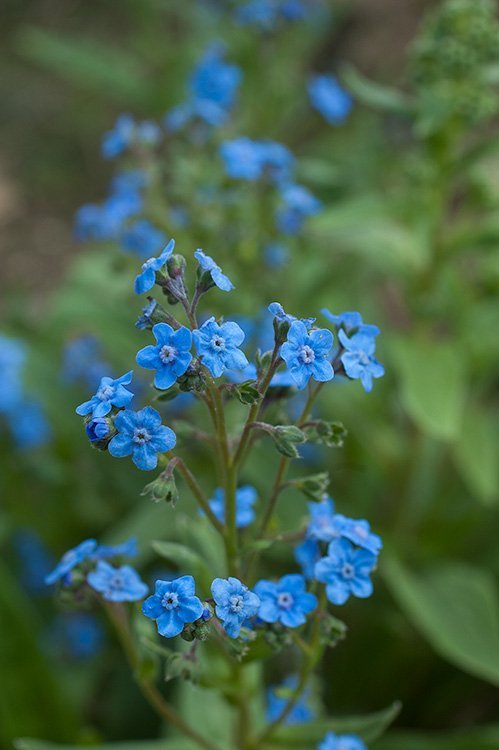
Cynoglossum amabile ‘Firmament’ - chinese forget me not
Category: Seminum | Sub-Category: Annuals for Sun
Scientific Name (Genus/Species): Cynoglossum amabile ‘Firmament’
Family: (Boraginaceae)
(A) to 2.5′. Chinese Forget-me-not. Producing all summer long a profusion of sky-blue, five-petalled flowers. Reminiscent of the Forget-me-not, only taller. Self-sows. Sun. 3, D & T2
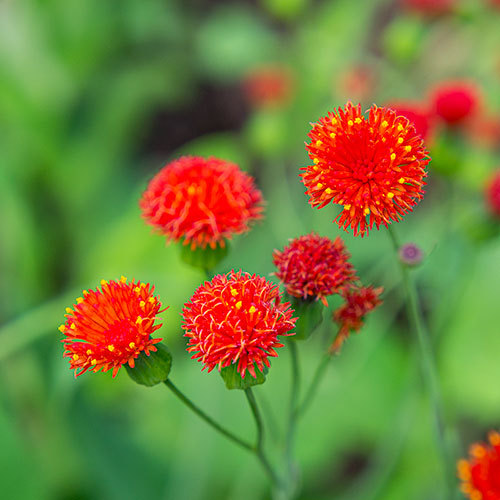
Emilia coccinea
Category: Seminum | Sub-Category: Annuals for Sun
Scientific Name (Genus/Species): Emilia coccinea
Family: (Asteraceae)
(A) to 3′. We love this selection of Tassel Flower. A native of Tropical Africa that produces a profusion of orange to scarlet, thistle-like flowers in terminal corymbs. Best if inter-planted or grown closely together. A real beauty in our Red/Orange/Yellow Bed. Sun.

Helleborus orientalis
Category: Seminum | Sub-Category: Woodland
Scientific Name (Genus/Species): Helleborus orientalis
Family: (Ranunculaceae)
(P) to 2′. Lenten Rose. Europe. Leaves are wide, dentate, glossy and evergreen. Nodding, cup-shaped, pinkish rose, five-petalled flowers have numerous cream stamens. An understated, long-blooming beauty. Early spring. Partial shade. 3 & 72° for 6 weeks, followed by 25-39° for 6-8 weeks.
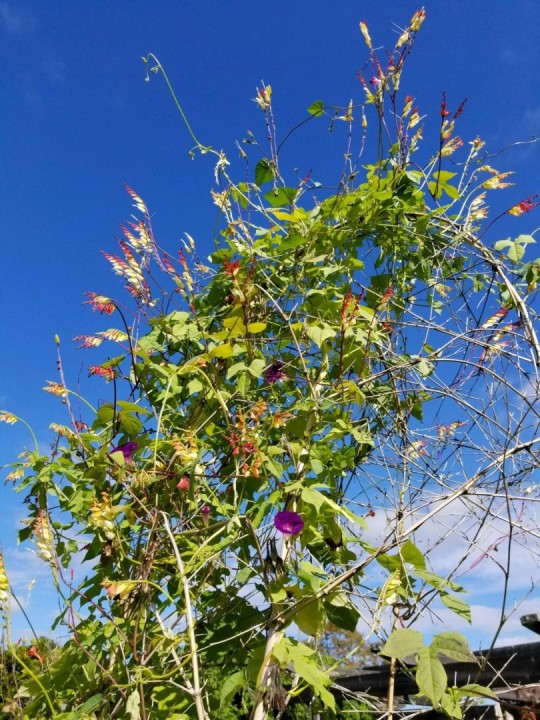
Ipomoea lobata (syn. Mina lobata) spanish flag
Category: Seminum | Sub-Category: Annuals for Sun
Scientific Name (Genus/Species): Ipomoea lobata (syn. Mina lobata)
Family: (Convolvulaceae)
Annual vine to 10′. Spanish Flag or Firecracker Vine. Mexico. An excellent, vigorous, twining vine with attractive, tri-lobed leaves and single-sided, six-inch long racemes of tubular flowers held on slender red stems. The flowers gently arc upward and outward, away from the vine, and mature from red to pale yellow, creating a gradient from the top to the base of the raceme. Blooms freely from mid to late summer until frost. The flowers are highly attractive to hummingbirds, butterflies, and other pollinators. A show-stopper on a tripod. Sun. 1, 2B, 3 & T3

Monarda punctata - Started seeds 5/3/2024
Category: Seminum | Sub-Category: Annuals for Sun
Scientific Name (Genus/Species): Monarda punctata
Family: (Lamiaceae)
(A) to 3′. Horse Mint. Native to the Great Plains of the United States. Dense whorls of pale yellow, hooded flowers spotted with purple-brown. Each whorl is surrounded by large, pink-tipped, green bracts. The narrow, toothed leaves have a grey cast. A very showy plant. Sun. 4 & T1
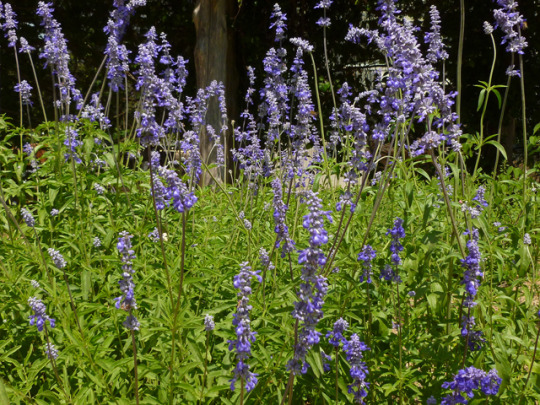
Salvia farinacea
Category: Seminum | Sub-Category: Annuals for Sun
Scientific Name (Genus/Species): Salvia farinacea
Family: (Lamiaceae)
(A) to 3′. Mealy Sage. Native to Texas and Mexico. Tubular, two-lipped, violet-blue flowers are densely congested in whorls along erect stems creating a 4″-8″ spike above the numerous grey-green, lance-shaped leaves. The common name is in reference to the mealy-white (sometimes purple) appearance of the sepals, which are covered with felted hairs. A long-bloomer. Sun/partial shade. 4 & T2
8 notes
·
View notes
Text
The Lantana and Verbena Report: Did they attract pollinators as you promised?
(L) Coleus in front of ‘Little Joe’ Joe Pye Weed; (R) Persian Shield with sweet potato vine.
About a year ago I asked you guys – the savvy, experienced gardeners who read this blog – for what “Potted Annuals for Pollinators” you’d recommend. I was unhappy with some annuals I’d been growing near my front door – which do soooo well but attract nothing. But what could I grow instead, here and in the tomato-red pots in my back garden where the ‘Standing Ovation’ Little Bluestem weren’t standing after all, and were so lackluster that even a commenter here on the Rant called them “underwhelming”? The truth hurts!
(I’m keeping the Persian Shield+sweet potato vine combo shown above despite their lack of appeal for pollinators (though holes in the vine tell me it’s supporting something). Look how great they still looked on November 1 when this photo was taken! And in this spot very close to my front door, I’m okay with no flowers and no bees, which I don’t want in my house.)
Back to the question I asked readers – out of concern for wildlife, sure, but also, selfishly, so that I could enjoy watching them from my patio – your answers were almost thrilling in the possibilities they opened up for this old gardener.
You suggested:
Annuals: Salvia ‘Lady in Red,’ butterfly sage (Salvia guaranitica), Salvia guaranitica ‘Black and Blue’, blue salvias generally, lantana (several votes), verbena, verbena bonariensis, pentas, ‘African Blue’ basil, bronze fennel, zinnias, Anise hyssop (Agastache foeniculum) (several votes), ‘Truffela Pinks’ Gomphrena, Lacy Phacelia, Teddy Bear sunflowers.Perennials: Red Valerian, lavender, Calamintha nepeta, single dahlias, catmints, gaillardias, “almost anything in the mint family, which includes Salvias,” wax begonias for hummingbirds, and as a filler, small hostas like ‘Golden Tiara’ or ‘Rainbows End.’
Wow!
What I Bought – Lantana ‘Red Spread’
After reading Ranter Elizabeth’s praise for the annuals she buys online, I chose one of her favorite suppliers (Select Seeds) and ordered some lantanas, and boy, did they perform! They bloomed like crazy until the first hard frost, and the growth pattern is perfect – mostly horizontal, so there’s need to hack them back to prevent flopping. I love the bold, vibrant color! Another wonderful surprise is that they don’t need deadheading. Not only do they bloom just fine without it, but the dying blooms (above) still look good right up until they fall off, so why bother?
Pollinator-wise, they performed like the champs you guys promised they’d be. Honestly I’d need a much better camera to capture the critters in stills, but I took videos throughout the season and I’ll have a short compilation to show you soon. (Preview: it’s the hummingbirds, sometimes two at a time, that steal the show.)
Here in my back garden, by mid-July I’d given up on the grasses in these pots and replaced them with some ‘Havana Red Sky’ lantanas that I found at my local farmer’s market. They took off right away and at the end of the season they were this size. And what a great match for the pots!
I was also happy to learn that lantanas are less thirsty than other annuals – I don’t think I ever saw them wilt.
What I Bought – Verbenas
The other completely new-to-me plant I bought from Select Seeds is this ‘Vanity’ verbena, which did attract some bees and butterflies but didn’t have much impact in my border. I’m going to try a shorter, bushier variety next time.
Extended Season for Pollinators – Done!
My tiny front garden was already attracting critters to the Joe Pye Weed, bronze fennel, Nepeta and wood aster, but with the addition of tropical annuals like verbena and especially lantana, the wildlife action now goes on continuously for a very long season.
Happier Gardener – Done!
So yeah, I love upping my garden’s game at performing important eco-services, like supporting pollinators.
But I’ll tell ya, adding SO many flowers to this small space outside my front door, near the patio where I sit and gaze upon the garden – that’s been thrilling! The combination of floral beauty with stunning insects swarming over them in the sun. You could say it’s upped my mental well-being.
Flowers just make us happy! They attract people to gardening and then reward their efforts with beauty to be enjoyed by them and their family and visitors.
Next month I’ll be ordering even more of your suggestions, for planting in pots and also to fill in open spots in my borders:
More ‘Red Spread’ lantana, plus some ‘Cherry Sunshine’‘Graffiti’ pentas‘Lollipop’ verbena‘Black and Blue’ salviaCosmos seedsPurple Bell vineI’ve already ordered a dwarf canna from a specialist, to replace the (nonblooming) banana in my largest pot.
That’s a lot to look forward to, for not a lot of money, or effort.
The Lantana and Verbena Report: Did they attract pollinators as you promised? originally appeared on GardenRant on December 22, 2023.
The post The Lantana and Verbena Report: Did they attract pollinators as you promised? appeared first on GardenRant.
Read More
0 notes
Text
Butterflies are Still Out
October, and time to tidy up, weed, and cut back the rudbeckia, and any other stragglers such as the Michaelmas which flowered early this year. But wait, what is that on the wall? Have you noticed the butterflies in the south west? Aren’t they remarkable? We planted lots of Verbena bonariensis, this year. Butterflies love them. They cheer me up in the autumn when most flowers are dormant, or…

View On WordPress
#2022#autumn flowers#beginners#flowers#gardening#Hermione Laake#October#purple flowers#Red admiral#Verbena bonariensis
0 notes
Photo


Verbena bonariensis which gently self seeds and blooms all summer. Its slim stems and low leaves don’t block or shade out lower perennials.
Plus butterflies and bees love them.
34 notes
·
View notes
Photo

Found this beautiful Red Admiral feasting on my lovely #verbena. TIP: In cold conditions Verbena bonariensis can suffer dieback if cut back in autumn, so it's best to leave the plant until spring and cut back the old growth when you see the new shoots emerging at the base. Also it's a good idea to mulch around the base of the plant with a deep, dry mulch in winter to help protect the plant. Where the plant is grown in partial shade the stems may need to be supported - if this is necessary use natural materials such as brushwood or twiggy pea-sticks. . Red Admiral (Vanessa Atalanta) - A large and strong-flying #butterfly and common in gardens. This familiar and distinctive insect may be found anywhere in Britain and Ireland and in all habitat types. Starting each spring and continuing through the summer there are northward migrations, which are variable in extent and timing, from North Africa and continental Europe. The immigrant females lay eggs and consequently there is an emergence of fresh butterflies, from about July onwards. They continue flying into October or November and are typically seen nectaring on garden buddleias or flowering Ivy and on rotting fruit. @savebutterflies . Verbena bonariensis (verbena) - Tightly packed clusters of lilac-purple flowers top the tall branching stems from June to September. This stylish perennial has been enjoying a resurgence of interest in recent years. It is perfect for a sheltered, sunny spot with well-drained soil and its open, transparent shape means that it can easily be used at the front, middle or back of the border. @crocus.co.uk . #flowers #flower #petal #petals #nature #beautiful #love #pretty #plants #blossom #sopretty #spring #summer #flowerstagram #flowersofinstagram #flowerstyles_gf #flowerslovers #flowerporn #botanical #floral #florals #insta_pick_blossom #flowermagic #instablooms #bloom #blooms #botanical #floweroftheday #mygarden https://www.instagram.com/p/Bm7ydiVFDKN/?utm_source=ig_tumblr_share&igshid=sg4tqbzwmjr7
#verbena#butterfly#flowers#flower#petal#petals#nature#beautiful#love#pretty#plants#blossom#sopretty#spring#summer#flowerstagram#flowersofinstagram#flowerstyles_gf#flowerslovers#flowerporn#botanical#floral#florals#insta_pick_blossom#flowermagic#instablooms#bloom#blooms#floweroftheday#mygarden
3 notes
·
View notes
Photo

Considering the popularity of Verbena bonariensis, you would expect Verbena rigida (Slender or Tuberous Vervain) to be better known. It isn’t commonly planted, but I have no idea why and so to encourage more planting it is today’s #oneadayplant . Verbena are a colourful group of Herbaceous Perennials (and some annuals), mostly from South America, though another underrated species V. officinalis is a European species. While not that many are hardy in the UK, there are at least six or seven species and varieties that will get through most of the winters we can throw at them. . I grew this and Verbena rigida ‘Polaris’ in a lawn as a meadow experiment a decade ago and it did really well. Better in fact than the Persicaria amplexicaulis I also added. . They really want decent drainage and plenty of sun, but don’t be fooled, they aren’t looking to be dry, only to not sit with water around their roots. They drink a surprising amount of water. V. rigida is shorter than most at a maximum of 45-60cm (18” - 2’) tall. Handsome purple flower clusters too narrow toothed (not sharp) leaves. Bees, Butterflies and other insects love them. . Look out for it and others. . #verbena #verbenarigida #vervain #herbaceous #perennials #plants #purple #flowers #brazil #argentina #southamerica #garden #iplantsman #plantingdesign #gardening #gardeningtips #gardeningadvice #flowering #summer #persicaria #persicariaamplexicaulis #violet #mauve #verbenarigidapolaris (at Wormit) https://www.instagram.com/p/CD_F0E8gGQV/?igshid=1de4gq76j6qh2
#oneadayplant#verbena#verbenarigida#vervain#herbaceous#perennials#plants#purple#flowers#brazil#argentina#southamerica#garden#iplantsman#plantingdesign#gardening#gardeningtips#gardeningadvice#flowering#summer#persicaria#persicariaamplexicaulis#violet#mauve#verbenarigidapolaris
0 notes
Text
22 Brilliant Ways To Advertise Verbena Hastata | Verbena Hastata
The aftermost two years, I’ve been burying accepted milkweed, accomplishing my allotment to accommodate aliment for autocrat butterflies. My focus has been on this one species, though, and I’ve afresh accomplished that I charge to aggrandize my bulb aficionado if I apprehend to attend added types of accepted butterflies.
When it comes to affable collywobbles into our garden, our focus generally avalanche to the arrangement of blooming plants that allure them. Equally important are the plants that serve as hosts for the abounding breed of collywobbles that are begin in our area.
Butterflies are specialists, acceptation that they await on one specific bulb on which to lay their eggs. Frequently referred to as host plants, these plants serve as the buoy for butterfly eggs, athirst caterpillars and adults. Once eggs accept hatched, the caterpillar larvae augment on the foliage of their host plant, molting through bristles instar phases.
By allotment added host plants for our gardens, we are allowance addition the butterfly action in our backyards and neighborhoods. It’s important to remember, though, that any host bulb you acquaint into your garden has the abeyant to become a accumulate of insect activity. Akin to abrogation your slippers out for your boisterous puppy, these host plants will bound be devoured by butterfly caterpillars.
Harriet McCarthy is an Extension Adept Agriculturalist Volunteer who has adherent her home garden to butterfly sustainability. She grows a abundant cardinal of butterfly host plants and maintains a certified autocrat way base at her home garden.
“You can allure collywobbles or you can abound butterflies,” McCarthy said. If you don’t appetite damaged plants, again don’t abound any of the host plants. You’
22 Brilliant Ways To Advertise Verbena Hastata | Verbena Hastata – verbena hastata | Welcome for you to my own blog site, in this time I will teach you concerning keyword. And after this, this is the 1st impression:

American vervain (Verbena hastata Stock Photo: 22 – Alamy – verbena hastata | verbena hastata
Think about image preceding? can be in which amazing???. if you think thus, I’l l demonstrate some image all over again down below:
So, if you’d like to get the outstanding images related to (22 Brilliant Ways To Advertise Verbena Hastata | Verbena Hastata), click on save button to download these pictures for your computer. There’re available for down load, if you’d rather and wish to grab it, click save logo on the page, and it will be instantly saved in your home computer.} Lastly in order to grab unique and the recent graphic related with (22 Brilliant Ways To Advertise Verbena Hastata | Verbena Hastata), please follow us on google plus or bookmark this site, we attempt our best to provide regular update with fresh and new photos. Hope you love keeping right here. For many up-dates and recent news about (22 Brilliant Ways To Advertise Verbena Hastata | Verbena Hastata) pics, please kindly follow us on twitter, path, Instagram and google plus, or you mark this page on bookmark area, We try to present you update regularly with all new and fresh photos, love your searching, and find the perfect for you.
Here you are at our website, contentabove (22 Brilliant Ways To Advertise Verbena Hastata | Verbena Hastata) published . At this time we’re delighted to declare that we have discovered an extremelyinteresting topicto be pointed out, that is (22 Brilliant Ways To Advertise Verbena Hastata | Verbena Hastata) Lots of people looking for specifics of(22 Brilliant Ways To Advertise Verbena Hastata | Verbena Hastata) and certainly one of them is you, is not it?

Verbena hastata – American blue vervain (22) – flowermedia – verbena hastata | verbena hastata

File:Verbena hastata – Blue Vervain | verbena hastata

Verbena hastata — Вікіпедія – verbena hastata | verbena hastata

Verbena hastata::Vivai Priola – verbena hastata | verbena hastata

PERENNIAL: Verbena hastata (Blue Vervain) | Master Gardeners of .. | verbena hastata

Verbena hastata (Blue Vervain): Minnesota Wildflowers – verbena hastata | verbena hastata

Medicinal Uses of Vervain | Northeast School of Botanical Medicine – verbena hastata | verbena hastata

Verbena hastata (Swamp Verbena) — Wetland Plants Inc – verbena hastata | verbena hastata

Verbena hastata – Dummer. ゛☀ – Garden Manage – GFinger is the .. | verbena hastata

VERBENA Pink Spires – verbena hastata | verbena hastata

Taking a DeLIGHT in Verbena bonariensis this Summer! – verbena hastata | verbena hastata

VERBENA hastata – verbena hastata | verbena hastata

How to Grow Blue Vervain Verbena Hastata – GrowIt BuildIT – verbena hastata | verbena hastata

Blue Vervain Seeds (Verbena hastata) 22+ Medicinal Herb Seeds – verbena hastata | verbena hastata

Verbena hastata – Study Plants Everyday – verbena hastata | verbena hastata

Verbena hastata “Alba ” – verbena hastata | verbena hastata

Verbena Monograph | Northeast School of Botanical Medicine – verbena hastata | verbena hastata

Knockout Blooms: Verbena Hastata Loves the Swamp – Lewis Ginter .. | verbena hastata

Verbena Blue Vervain Hastata 100 Seeds | Etsy – verbena hastata | verbena hastata

Verbena hastata ‘White Spires’ / Vervain / Seeds – verbena hastata | verbena hastata

Verbena hastata "Blue Vervain" Sun Wet Mesic/Mesic 3-6ft .. | verbena hastata
The post 22 Brilliant Ways To Advertise Verbena Hastata | Verbena Hastata appeared first on Flower Nifty.
from Wallpaper Nifty https://www.flowernifty.com/22-brilliant-ways-to-advertise-verbena-hastata-verbena-hastata/
0 notes
Photo

Confession: I had no idea that Verbena bonariensis had anything to do with Buenos Aires, but this South American plant does take its botanical name from the capital city of Argentina, and one of its common names in English is Argentinian vervain. I had this flower at the castle 15 years ago, but it did even better at Corte Eremo, between 2012 and 2015, where it loved to grow in the gravel drives. Butterflies everywhere because of it! #verbenabonariensis #verbenaceae #corteeremo #southamericanflowers #purpleflowers #plantnames #botanicalcuriosity #gardensofinstagram #gardeners #ihadnoidea (presso La Macchina Fissa) https://www.instagram.com/p/CAbT0jhJhBW/?igshid=1nwdb8c6x97dz
#verbenabonariensis#verbenaceae#corteeremo#southamericanflowers#purpleflowers#plantnames#botanicalcuriosity#gardensofinstagram#gardeners#ihadnoidea
0 notes
Text
Wildlife garden design ideas
'The way we see it, our gardens don't belong to us alone – they belong to all the wildlife that lives there, eats there or even just uses them as a stopping off point,' says award-winning garden designer Michael John McGarr of Warnes McGarr & Co. 'This could involve the hedgehog that wanders through your garden at night, the birds that stop off in the thick shrubbery, right through to the beetles and woodlice that live under a stone at the end of the garden.'
It doesn't take a huge amount of effort to ensure wildlife can flourish in your garden within a complete redesign. It really just takes a good awareness of what creatures need and hopefully you should be able to enjoy your new garden alongside the birds, butterflies and bees. At Warnes McGarr & Co, Michael is used to working with ultra-high end and high-tech designs, creating expensive outdoor kitchens and outdoor cinemas or seating areas with televisions – but in equal measures he can be found at bottom of the garden building a beetle bank, or cutting hedgehog passes in the fencing. How to Revive An Air Plant https://www.justhomegardening.com/how-to-revive-an-air-plant
Here, Michael talks through the top five ways you can include wildlife in your garden and landscaping design.
1. Keep some mature existing shrubs and trees
'If a client wants a complete garden redesign, especially if they've just moved in, they may want everything pulling out the garden and a complete redesign from scratch. As designers, this would be a fantastic brief for us, however, we would always be mindful of how garden creatures and birds might use the existing mature greenery,' begins Michael.
'If you sit in your garden for long enough and watch a specific shrub, bush or tree, you will see the flow of birds, animals or insects that either pass through it, or live there.'
Michael says it's not always possible to keep every mature tree or large shrub, but 'if we can keep a mature plant in a garden that could provide shelter for small birds, a home for a frog or hedgehog and numerous insects, then we will try to include it in our designs'. Best Gardening Tool Set for Mom : Delightful Gift For Mom Gardener https://www.justhomegardening.com/best-gardening-tool-set-for-mom-delightful-gift-for-mom-gardener
2. Think about the movement of hedgehogs
Becoming an increasingly rare sight in our British gardens, hedgehogs are losing their habitats at an alarming rate. 'One of the reasons for this is that they can travel around 2km every night looking for food, but more and more gardens are becoming closed off with secure boundaries like fences and gates,' Michael explains. 'Concrete bases for fence panels create an impenetrable barrier for a hedgehog, so we always ensure that fence panels we create for clients have a "hog-hole" cut in the bottom to allow them to freely access a garden, if they wish.'
You'll only need a gap of 13cm x 13cm for hedgehogs to get through. Better still, if you want to help hedgehogs, look at how to create a 'hedgehog highway' with your neighbours.
3. Planting for pollinators
'Luckily, we don't have to do much persuading when it comes to creating a wildlife planting scheme, as the flowers that bees and other pollinators love, are also just as attractive to the human eye,' says Michael. 'Try to incorporate a range of native/ indigenous planting where possible to support bugs and insects with both food and shelter. 'We often use Borage; Lavender; different varieties of Echinacea, Salvias, Alliums and Verbena bonariensis in our planting designs to attract bees, hoverflies, butterflies and moths. We also recommend Viper's Bugloss (Echium vulgare) if you have a sheltered site, as the stunning bright blue flowers are very popular with bees. 'Teasels (Dipsacus fullonum) are brilliant for providing height and structure in wildflower gardens. They are loved by insects and pollinators for their nectar, and the seeds are adored by goldfinches. Teasels do like to self-seed so ensure you pull up any seedlings that encroach into areas you don't want them. 'We also recommend a large native grass called Pendulous sedge (Carex pendula) that are great for frogs to hide within. This can grow quite large, so do be prepared to divide and cut back every year,' Michael explains. How To Get Rid Of Bugs In Houseplants Soil https://www.justhomegardening.com/how-to-get-rid-of-bugs-in-houseplants-soil
With so many different species of trees, Michael also suggests some which you can plant specifically for wildlife. 'One of our favourites is the hawthorne (Crataegus monogyna), which can also be planted as hedging,' he reveals. 'This attractive native species is also fantastic for wildlife and can host more than 300 insects. Its pollen in spring is an important source of food for bees, while the bright red fruits in autumn are also eaten by birds.'
Meanwhile, for shrubs, think outside of the standard buxus which suffer from a number diseases. 'Think of drought-tolerant indigenous shrubs such as Mountain Pine (Pinus mugo) with which you can create a strong striking evergreen structure within the garden,' he says.
4. Leave an area of unmown lawn
'With our larger garden design clients we often talk through the possibility of leaving patches of unmown grass, at the end of a garden or around some trees,' says Michael. 'We think long grasses can look beautiful, especially when they go to seed. However, this can also be so beneficial to the environment and your garden wildlife, by providing areas of shelter. It doesn't take long for wild flowers to also seed themselves within the grass.' A ready-planted wild flower turf is another option. You can create a low-maintenance wild flower meadow within your garden, and all you'll need to do is cut it back once a year. How To Care For A Yucca Plant: A Comprehensive Guide For Beginners https://www.justhomegardening.com/how-to-care-for-a-yucca-plant-a-comprehensive-guide-for-beginners
5. Provide a habitat for frogs
'You don't even need a full-size pond to have frog residents set up home in your garden,' says Michael. 'A small sunken basin or attractive bowl can provide a place for them to breed and have a swim. Then you need to have lots of ground-cover plants or mature shrubs and woody plants to provide shelter and habitat for them. 'Cats, hedgehogs and larger birds will also eat (or just kill, in the case of cats) frogs, so it really is important to have somewhere they can remain well hidden. A pile of rocks next to your mini-pond can provide the perfect hiding hole for frogs, or even a toad, if you're lucky.'
0 notes
Video
instagram
We love these skipper butterflies & they love the Verbena bonariensis nectar. #pollinators #butterflies #nature (at Lewis Ginter Botanical Garden) https://www.instagram.com/p/BoKBX0lnDji/?utm_source=ig_tumblr_share&igshid=xvw9wl3b93ys
0 notes
Text
Bachelors Buttons are an old favorite with the most intense blue color
Old timey annuals are back in! Pushed to the side for many years in favor of newer, supposedly better cultivars, I always remember growing these as a child and seeing them in my parents garden. I couldn’t wait to squeeze the snapdragon flowers to make the “mouth” open like a dragon when I was little. Or being fascinated by the pansy faces that I grew and pressing them between the pages of a phone book.
Pansy flower
Violas in a container
With all the new intros of flowers, people forget the old-fashioned flowers that our grandmothers grew and enjoyed. ‘Flowers with a past’, or ‘flowers with history’ intrigue me even in the face of the slant in favor of perennials in recent years. So many people when they hear that a plant is an annual dismiss it as not worth the time and money to plant. But even in a garden of plant snobs, there is room for a diverse choice of antique flowers.
Rarely seen anymore, Balsam flower is extremely easy to grow
Never having given up on clarkia, cleome, calendula, cornflower, and cosmos, I have never stopped growing these neglected blooms and invite other flower lovers embrace them as well. Neglected but not forgotten, all these flowers should be planted and enjoyed by another generation.
Edible Nasturtiums are easy to grow
Nasturtiums
Heirloom annuals are plants that have been cultivated for at least one hundred years, and some for much longer. Unimproved flowers that hybridizers haven’t got their hands on, antique annuals bloom profusely all season long and set seed so that you can collect them to flower for another year. Even better, many reseed to continue growing for the next season. Many are tall and graceful, not short and stocky hybrids that fit into containers and smaller gardens that are more prevalent today.
Sticky Cleome is native to South America and looks spidery, hence its common name, Spider Flower
Difficult to have something in bloom all season long, a perennial border is just shouting out to have annuals inserted in empty spots so you can have a constant parade of blooms.
Beautiful ruffled Cosmos at Falkland Place in Scotland
Sweet Peas at Falkland Palace in Scotland
Closeup of Sweet Pea
Perennial purists who will not allow an annual to cross through their garden gate are missing out on the dizzying palette of flowers that flower and die in one season. Perennial is a term that can be interpreted several ways. I have some short-lived perennials that only last two or three seasons, like lavender. The drainage issue always does this picky perennial in. So, the term perennial could mean – lasts for many seasons, like a peony… or perennial for a few seasons, like some of the new Echinaceas. Echinaceas don’t seem to last very long at all and yet they are called perennials.
I love all the new Echinaceas, but they seem to last only a couple of seasons
Poppies are one of my favorite old fashioned annuals
Blue Poppy
When most perennials are on their last gasp in late summer, many annuals are still running strong with little care. A bit of dead heading, sometimes staking, and an infusion of fertilizer is enough to keep them in good form all summer. Some annuals like Poppies, Love in a Mist, Bells of Ireland, Clarkia, and Larkspur are definitely cool weather plants finished by June. See my post on Cool Season Annuals.
Purple Larkspur makes a fine foil for pink Poppies
Cool season Bells of Ireland
Unusual on the east coast, Clarkia is an annual that does better on the west coast
Love in a Mist is aptly named
Dried seed pods of Nigella or Love in a Mist
Cultivated for thousands of years in the Americas, Zinnias are a true antique classic. According to Burpee’s website, “Zinnias are undemanding annuals that simply need full sun, warmth, and well-drained soil rich in organic matter. If soil is poor, incorporate lots of compost or leaf mold”. Like many old-fashioned annuals, Zinnias do better sown directly into the garden instead of being transplanted.
Zinnias draw butterflies
Plumed Celosias are bursting with new cultivars but I really like to grow the unique Crested Celosia. I love the brain-like texture of the velvety bloom and it dries beautifully.
Good for drying, Crested Celosia has a fascinating bloom
Blue Lace Flower
Blue Lace Flower, Trachymeme coerulea, resembles a purple Queen Anne’s Lace and would look good in a cottage style garden border. Coming from Australia in 1828, you can find this plant reseeding year after year into beds without any special care. Great for cutting and bringing into the house like many heirlooms, arranging with any of these long-stemmed flowers is a delight.
Larkspur and snapdragons from the garden make a fine arrangement
Annie’s Annuals in San Francisco is a nursery that specializes in Heirloom annuals; this is one of their demo gardens
All of these heirlooms draw pollinators in droves to their open faced flowers, with easily available pollen and nectar. To see more plants and flowers that attract pollinators, go to Plant These For Bees.
Plant These For The Bees poster available on Etsy
Mexican Sunflower is a butterfly magnet and easy for butterflies to nectar from
False Queen Anne’s Lace or Ammi majus is a great filler flower for arrangements
A great cottage border of heirlooms Zinnias and Verbena
Love Lies Bleeding or Amaranthus
An arrangement with Bells of Ireland and Love Lies Bleeding
Heirloom Annuals
False Queen Anne’s Lace, Ammi majus
Hollyhock, Alcea rosea
Clarkia
Love Lies Bleeding, Amaranthus
Spider Flower, Cleome
Snapdragon, Antirrhinum
Larkspur, Consolida
Cosmos
Sunflower, Helianthus
Globe Amaranth, Gomphrena
Heliotrope
Balsam, Impatiens balsamina
Sweet Pea, Lathyrus
Four O’Clock, Mirabilis
Pansy and Viola
Lobelia
Flowering Tobacco, Nictotiana
Love in a Mist, Nigella
Poppy, Papaver
Dusty Miller, Senecio
Mexican Sunflower, Tithonia
Blue Lace Flower, Trachymene coerulea
Zinnia
Verbena, Verbena bonariensis
Calendula, Pot Marigold
Petunias
Love in the Mist or Nigella has unusual flowers and pods
An arrangement with Bells of Ireland and Love Lies Bleeding
Annie’s Annuals is a nursery that specializes in Heirloom annuals; this is one of their demo gardens
Unusual on the east coast, Clarkia is an annual that does better on the west coast
Purple larkspur makes a fine foil for pink poppies
Larkspur and snapdragons from the garden make a fine arrangement
Blue Lace Flower
Zinnias
Good for drying, crested celosia has a fascinating bloom
Edible nasturtiums are easy to grow
Sticky cleome is native to South America and looks spidery, hence its common name, Spider Flower
Cosmos at Falkland Place in Scotland
Sweet Peas at Falkland Palace in Scotland
Closeup of Sweet Pea
Poppies are one of my favorite annuals
Blue poppy
Cool season Bells of Ireland
Dried seed pods of Nigella
Nasturtiums
Plant These For The Bees poster available at
Heirloom Annuals Old timey annuals are back in! Pushed to the side for many years in favor of newer, supposedly better cultivars, I always remember growing these as a child and seeing them in my parents garden.
#antique annuals#balsam flower#bells of Ireland#Clarkia#cool season annuals#cornflower#cottage garden#heirloom annuals#larkspur#love in a mist#love lies bleeding#nasturtiums#nigella#old fashioned annuals#old time annuals#plant these for the bees poster#Poppies#sweet peas
0 notes